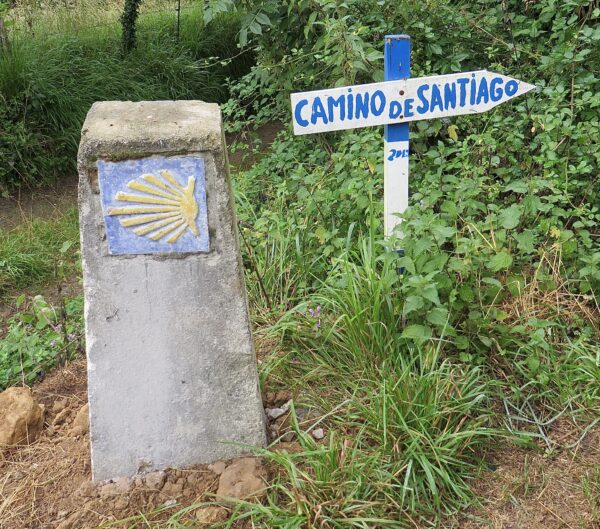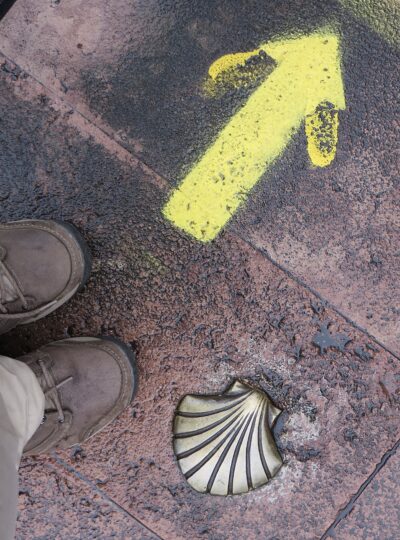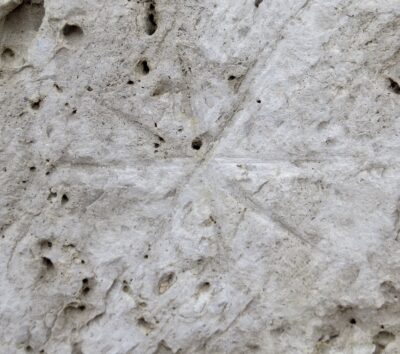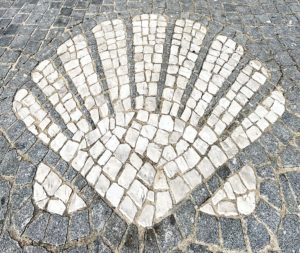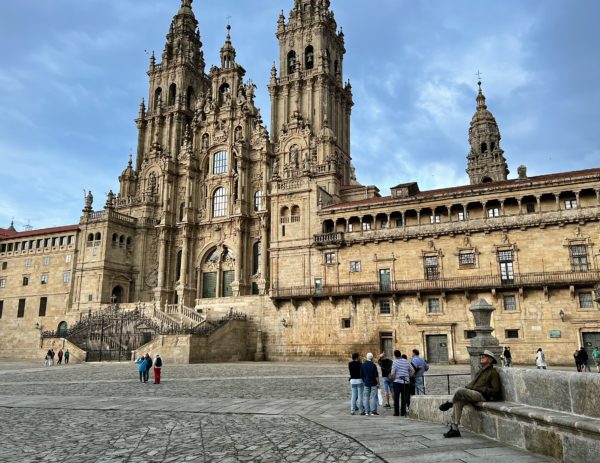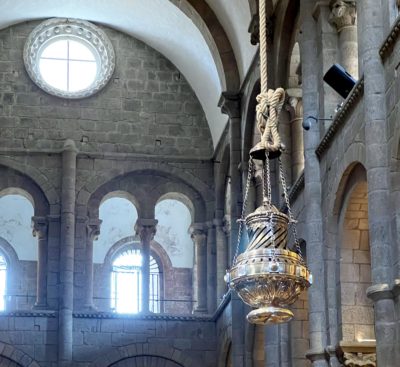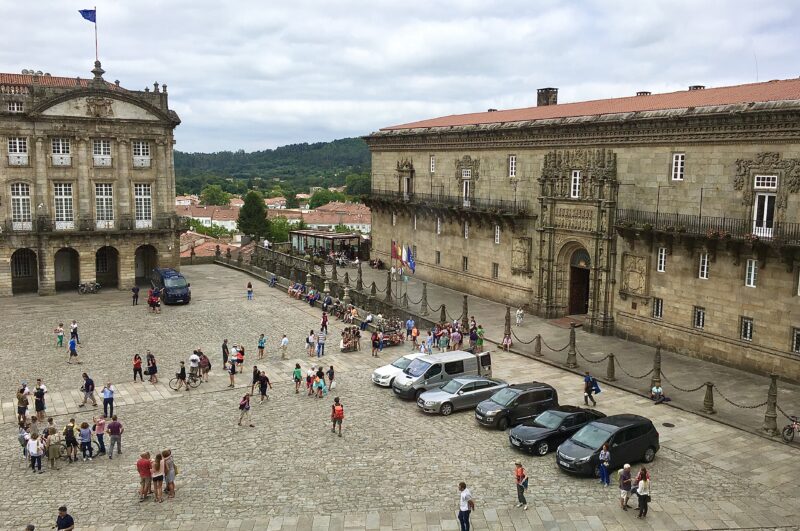The Camino de Santiago, Part 2
How do walkers navigate the Camino?
Walkers use guidebooks & apps for navigation that provide maps, lodging info, and details about trail surfaces. In addition, each Camino route has a vast system of markers, shells, yellow arrows, and road signs that help guide pilgrims along the path.
A popular guidebook for English speakers is the Pilgrim’s Guide to the Camino de Santiago by John Brierley, who offers guides for Camino Frances, Camino Portuguese, Camino Finisterre, and more routes. Other English guidebooks include A Village to Village Guide to Hiking the Camino de Santiago by Anna Dintaman & David Landis and also books from Cicerone and The Confraternity of St. James with guides for routes in Spain, France, and elsewhere.
Camino apps complement guidebooks — some walkers prefer them over hard copy guides — apps don’t weigh anything & include website links to lodging, etc. In addition, apps with navigation (such as Organic maps, Wise Pilgrim, & other GPS apps) provide maps & directions if needed; they’re especially handy for quieter routes where marking may be spotty. For the complete list of guidebooks & apps check out Camino Resources, Part 1.
Although guides/apps are advisable for overall navigation, walkers primarily follow a system of markers, shells, yellow arrows, & signage for directions while on the trail. These visual aids are found all along the pilgrim Road, whether in towns, rural areas, or wooded paths. While some markers date back centuries, many were installed in recent decades because of the Camino’s increasing popularity.
Each region has their own marker design — many are made from stone/cement while others are wood or metal posts. Walkers often place stones (piedras) on top of stone/cement markers — doing this can symbolize an unburdening of some sort or also mean that you will return and walk again.
Metal shells or ceramic tiles with shells are found imbedded into city streets, sidewalks, or buildings to help guide walkers through urban areas. Also, Camino signage often appears near roadways that the trail sometimes parallels or crisscrosses. These signs typically include an image of a pilgrim, a shell, & an arrow (flecha).
Yellow arrows:
The most common trail guidance for walkers are yellow arrows. They’re painted on pavement, buildings, fenceposts, trees, rocks, markers, etc. – it’s hard to predict where they’ll be! This network of yellow arrows is attributed to Don Elías Valiña Sampedro, a parish priest from the mountain village of O’Cebreiro in Galicia.
Don Elías studied the Camino and promoted it until his passing in 1989. He published a guidebook in the early 1980s and also began marking Camino Frances with yellow arrows to help walkers navigate the path. Why the color yellow? Apparently, Don Elías asked the Spanish Dept. of Transportation for paint — they probably had plenty of yellow to offer him. It was a good choice for visibility and already associated with hiking trail markers in Galicia.
Today, because of Don Elías & others who helped mark the Camino, yellow arrows are significant to navigation. Walkers may even get “yellow arrow syndrome” after finishing their journeys. This ‘condition’ occurs when you can’t stop looking for yellow arrows wherever you go!
Following the Milky Way:
In the Middle Ages pilgrims had available for navigation the Codex Calixtinus, a 12th c. manuscript devoted to St. James. It’s attributed to a French monk, Aymeric Picaud, and includes what is considered to be the first guidebook for the Camino. Picaud wrote about his impressions of the people, landscapes, and cultures encountered along the Road to Santiago. He listed an ‘itinerary’ of town names that walkers could follow.
Most medieval pilgrims, however, likely navigated by following the stars (estrellas) of the Milky Way. This galaxy lies above the Road; thus, the Camino is sometimes referred to as “Following the Milky Way” — there’s even a saying that the Milky Way was formed by “the dust of pilgrims’ feet.” Also, star markings were inscribed onto buildings to help with guidance. The photo shows a star carved onto the stone walls of 13th c. Ermita de San Nicolas near Itero de la Vega, a town on Camino Frances. The mark confirmed to walkers that the chapel was indeed located on the pilgrimage route.
An English translation of the Codex Calixtinus is in The Pilgrim’s Guide to Santiago de Compostela by William Melczer (listed in Camino Books, Films, etc.).
“Buen Camino”
In the past, pilgrims expressed greetings to each other by saying the word “Ultreia,” which translates in Latin as “go forward” or “onward.” Upon hearing it, walkers responded with “Et Suseia” that means “upward” or “go higher.” The phrase “Ultreia et Suseia” has historical context to the Camino since it appears in the Codex Calixtinus as part of an 11th c. hymn and liturgy.
In recent decades, this greeting was replaced with the phrase “Buen Camino” (or “Bom Caminho” on the Portuguese routes) that translates as “good way” or a wish to ‘have a good journey.’ This popular expression will be heard many times on a Camino walk!
The Catedral de Santiago de Compostela went through a massive restoration in recent years. The structure was originally built in the 11th-12th c. with expansions done in the 16th-18th c.
Pilgrim traditions:
Along with receiving a Compostela, other walker traditions & things to see in Santiago include:
- Obradoiro Plaza — This is the traditional Camino endpoint in front of the Cathedral (shown above). “Obradoiro” translates as “workshop” in reference to workshops established in the plaza during the building’s construction. In the center are two plaques where walkers mark their finish. One plaque designates the Camino as the 1st “European Cultural Itinerary” awarded in 1987 by the Council of Europe — it honors the Camino’s importance as a cultural exchange since the Middle Ages. The other plaque commemorates the Holy Year in 2004. See the plaques in Photos, Camino Frances.
- Pilgrim’s Mass — The Cathedral holds Pilgrim Masses at 7:30 a.m., 9:30 a.m., noon, & 7:30 p.m. Check the Cathedral’s website for further info & schedule updates. Masses in English are held daily (except Wed.) at 10:30 a.m in the Pilgrim’s Office chapel.
- Botafumiero — The Cathedral’s Botafumiero (“smoke spreader” or “belcher”) is an over 5 ft. tall brass & bronze incense burner, which is sometimes swung at the end of the Pilgrim’s Mass or on religious holidays. Eight red-robed men called tirabolieros (“incense carriers”) swing the 132 pd. censer by pulling a rope on a pulley in the dome above the altar (crossing dome). The Botafumiero is also on view in the Museum Library. Check out the Cathedral’s website for further info & a video of it swinging.
- Hug St. James — A pilgrim tradition is to hug the Cathedral’s altar statue of St. James. Stairs behind the altar lead up to where walkers can put their arms around the saint to give thanks for their journeys.
- Crypt of St. James — A short flight of stairs under the altar leads down to a small space where walkers can view the reliquary & also see the stonework of the original church structure.
- Holy Years — These occur when St. James’ Feast Day, July 25th, falls on a Sunday. Special events & celebrations are scheduled during these years; also a special credencial is issued. The next Holy Year is 2027.
During the Middle Ages the Botafumiero was associated with prayer and also helped to fumigate smelly pilgrims.
More pilgrim traditions & things to see in Santiago:
- Cathedral Museum & rooftop tours — The museum features exhibits about the building’s history & art. The rooftop tours (in Spanish or English) offers aerial views & info on the Cathedral’s history. Check at the museum office for the schedule & tickets (combo tickets available); bring your credencial to get a discount. Tickets can also be purchased online.
- Portico da Gloria — The Cathedral’s original 12th c. entrance (on the west side) is the newly refurbished Portico da Gloria (“Porch of Glory”) by the architect & sculptor Master Mateo. The central column (or mullion) shows St. James seated above the Tree of Jesse. Pilgrims in centuries past put their fingers in grooves worn over time on the column. Although this tradition is no longer allowed, see it done in the film The Way. Take a tour (in Spanish); free visits are available online.
- Museum of Pilgrimage and Santiago — Located adjacent to the Cathedral, the museum includes exhibits about Santiago’s pilgrimage history & also pilgrimage around the world. A discount is available for walkers with Compostelas.
- Old town Santiago — After the Camino, many walkers spend time in Santiago to explore the medieval old town, designated as a UNESCO World Heritage Site. This area buzzes with the energy of arriving pilgrims, tourists, & students from the University of Santiago. Lots of restaurants and shops line the streets.
- Finisterre — If you’re walking onward from Santiago to Finisterre on the coast, the tradition is to finish at the lighthouse (faro) there. Behind the building is a monument to pilgrims & a ‘burn pile’ where walkers burn clothes, etc. as an ‘unburdening’ or to signal the end of their journeys. This may not be an environmentally friendly practice, though!
Adjacent to the Cathedral is the parador Hostal dos Reis Catolicos (on the right), which was built in the 15th c. as a pilgrim hospital. The hospital’s guidelines stated that it had to provide free accommodations & meals to pilgrims for 3 days. This medieval tradition is still honored today — tickets for a free lunch (at 13:00) are given to the first 10 people in line to receive a Compostela at the Pilgrim’s Office.

